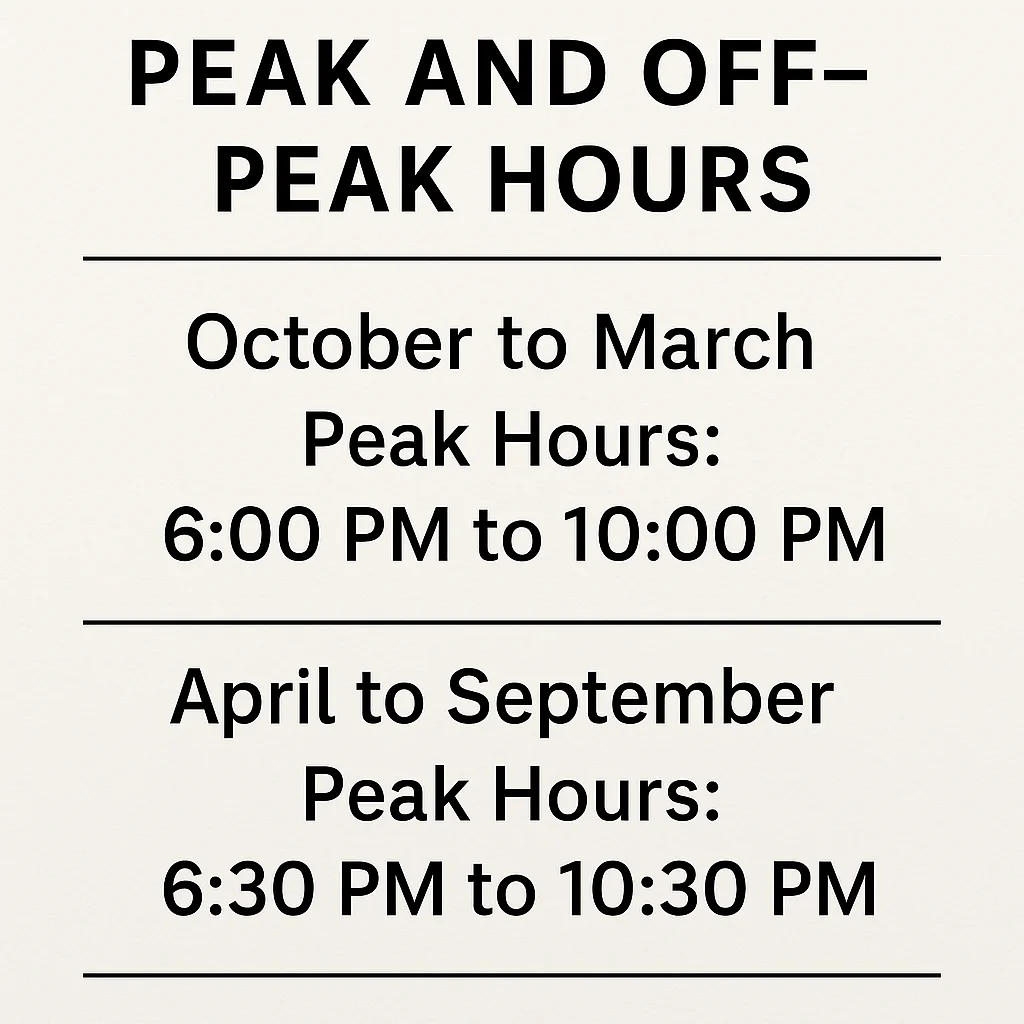FESCO Peak Hours – Save Electricity, Save Money in 2025
Are your electricity bills higher than expected? You might be using appliances during the wrong time of the day. Knowing the FESCO Peak Hours Timing 2025 and adjusting your usage accordingly can help you save a significant amount of money. Whether you’re checking FESCO peak hours or planning your usage for tomorrow, understanding the difference between FESCO Peak and Off-Peak Hours is essential.
Faisalabad Electric Supply Company (FESCO) implements time-based electricity tariffs to balance demand on the grid. During peak hours, when the demand is high, the per-unit electricity rate is also high. However, during FESCO Off-Peak Hours, the rates are lower, encouraging consumers to shift their high-energy tasks to these cheaper periods.
FESCO Peak Hours Timing 2025
Here’s the official FESCO Peak and Off-Peak Hours schedule for 2025:
| Season | Peak Hours | Off-Peak Hours |
|---|---|---|
| October to March | 6:00 PM to 10:00 PM | Remaining 20 hours of the day |
| April to September | 6:30 PM to 10:30 PM | Remaining 20 hours of the day |
These timings are defined by FESCO based on seasonal demand and are applied across its entire service region. Staying updated with the FESCO peak hours timing 2025 ensures you always make informed decisions when using electricity-intensive appliances.

Why FESCO Peak and Off-Peak Hours Matter?
In Pakistan, especially in Faisalabad and nearby areas, electricity consumption patterns follow a predictable trend. When everyone returns home in the evening and turns on lights, fans, air conditioners, and other appliances, demand spikes. These periods are classified as peak hours. Electricity consumed during this time is billed at a higher tariff.
On the other hand, FESCO Off-Peak Hours cover the rest of the day when demand is lower and electricity is cheaper. By understanding and adjusting to FESCO peak hours today, consumers can avoid high tariffs and reduce their monthly FESCO bill.
What Drives High Demand During FESCO Peak Hours?
Understanding why these hours are more expensive helps in adjusting our routines. Several key factors influence peak demand:
1. Evening Appliance Usage
Most households turn on multiple devices after 6 PM—fans, ACs, TVs, microwaves, washing machines, and more—all contribute to a rapid surge in electricity consumption.
2. Seasonal Load
In summer, air conditioners and water coolers are in high demand, especially between April and September. This increases pressure on the grid, resulting in peak hour surcharges.
3. Combined Residential & Commercial Load
In urban areas like Faisalabad, industrial and commercial energy consumption sometimes overlaps with residential usage, further stressing FESCO’s distribution system.
How to Manage Electricity Usage During Peak Hours?
To avoid higher bills and support grid stability, here are some practical solutions:
Use High-Energy Devices in Off-Peak Hours
Run your washing machines, irons, geysers, and electric ovens during the FESCO Off-Peak Hours when electricity rates are lower.
Switch to Energy-Efficient Appliances
Invest in appliances with high energy ratings (like inverter ACs and LED lighting). These consume less power and help cut costs even during peak hours.
Install a Smart or TOU (Time-of-Use) Meter
A Time-of-Use meter helps you track when and how much electricity you’re using during different times of the day. It gives you better control over your power usage habits.
Automate Energy Usage
Use timers or smart plugs to automatically switch off devices after a set time. This reduces unnecessary usage during FESCO peak hours today.
Common Mistakes That Raise Your FESCO Bill
Even with awareness of FESCO Peak and Off-Peak Hours, people often unknowingly drive up their energy consumption. Avoid these pitfalls:
- Running multiple heavy appliances simultaneously after 6 PM.
- Keeping lights and fans on in unused rooms.
- Not unplugging devices that remain on standby mode.
- Using older, inefficient appliances that consume excessive energy.
Myths About FESCO Peak Hour Traffic (And the Truth)
You might have heard people say, “There’s no difference in power use—it’s the same all day.” This is false. FESCO Peak Hours Timing 2025 follows a strict seasonal schedule, and the tariff difference between peak and off-peak is officially declared by NEPRA.
Also, many believe the peak hour charges apply only to commercial users. That’s incorrect. Residential consumers with TOU meters are also charged based on these timings.
FESCO Peak Hours – FAQs
Conclusion
Understanding FESCO Peak and Off-Peak Hours is no longer optional—it’s a smart, cost-effective strategy for every household and business. With energy prices rising and electricity consumption increasing day by day, adopting smarter habits during FESCO peak hours today can make a real difference.
From adjusting your usage patterns to investing in smart appliances, the steps are simple but effective. By following the FESCO peak hours timing 2025, you’ll not only reduce your energy bills but also play a role in stabilizing the power supply across Faisalabad and nearby regions.